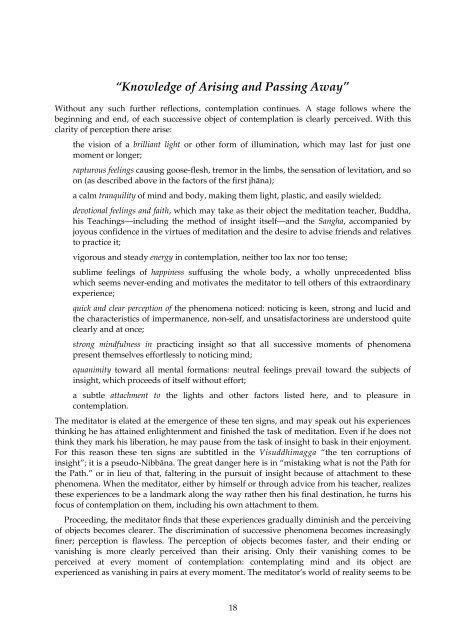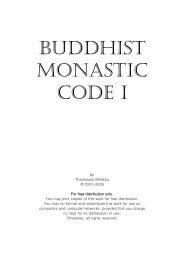THE BUDDHA W MEDITATION - Theravada Buddhism
THE BUDDHA W MEDITATION - Theravada Buddhism
THE BUDDHA W MEDITATION - Theravada Buddhism
You also want an ePaper? Increase the reach of your titles
YUMPU automatically turns print PDFs into web optimized ePapers that Google loves.
“Knowledge of Arising and Passing Away”<br />
Without any such further reflections, contemplation continues. A stage follows where the<br />
beginning and end, of each successive object of contemplation is clearly perceived. With this<br />
clarity of perception there arise:<br />
the vision of a brilliant light or other form of illumination, which may last for just one<br />
moment or longer;<br />
rapturous feelings causing goose-flesh, tremor in the limbs, the sensation of levitation, and so<br />
on (as described above in the factors of the first jhāna);<br />
a calm tranquility of mind and body, making them light, plastic, and easily wielded;<br />
devotional feelings and faith, which may take as their object the meditation teacher, Buddha,<br />
his Teachings—including the method of insight itself—and the Sangha, accompanied by<br />
joyous confidence in the virtues of meditation and the desire to advise friends and relatives<br />
to practice it;<br />
vigorous and steady energy in contemplation, neither too lax nor too tense;<br />
sublime feelings of happiness suffusing the whole body, a wholly unprecedented bliss<br />
which seems never-ending and motivates the meditator to tell others of this extraordinary<br />
experience;<br />
quick and clear perception of the phenomena noticed: noticing is keen, strong and lucid and<br />
the characteristics of impermanence, non-self, and unsatisfactoriness are understood quite<br />
clearly and at once;<br />
strong mindfulness in practicing insight so that all successive moments of phenomena<br />
present themselves effortlessly to noticing mind;<br />
equanimity toward all mental formations: neutral feelings prevail toward the subjects of<br />
insight, which proceeds of itself without effort;<br />
a subtle attachment to the lights and other factors listed here, and to pleasure in<br />
contemplation.<br />
The meditator is elated at the emergence of these ten signs, and may speak out his experiences<br />
thinking he has attained enlightenment and finished the task of meditation. Even if he does not<br />
think they mark his liberation, he may pause from the task of insight to bask in their enjoyment.<br />
For this reason these ten signs are subtitled in the Visuddhimagga “the ten corruptions of<br />
insight”; it is a pseudo-Nibbāna. The great danger here is in “mistaking what is not the Path for<br />
the Path.” or in lieu of that, faltering in the pursuit of insight because of attachment to these<br />
phenomena. When the meditator, either by himself or through advice from his teacher, realizes<br />
these experiences to be a landmark along the way rather then his final destination, he turns his<br />
focus of contemplation on them, including his own attachment to them.<br />
Proceeding, the meditator finds that these experiences gradually diminish and the perceiving<br />
of objects becomes clearer. The discrimination of successive phenomena becomes increasingly<br />
finer; perception is flawless. The perception of objects becomes faster, and their ending or<br />
vanishing is more clearly perceived than their arising. Only their vanishing comes to be<br />
perceived at every moment of contemplation: contemplating mind and its object are<br />
experienced as vanishing in pairs at every moment. The meditator’s world of reality seems to be<br />
18






